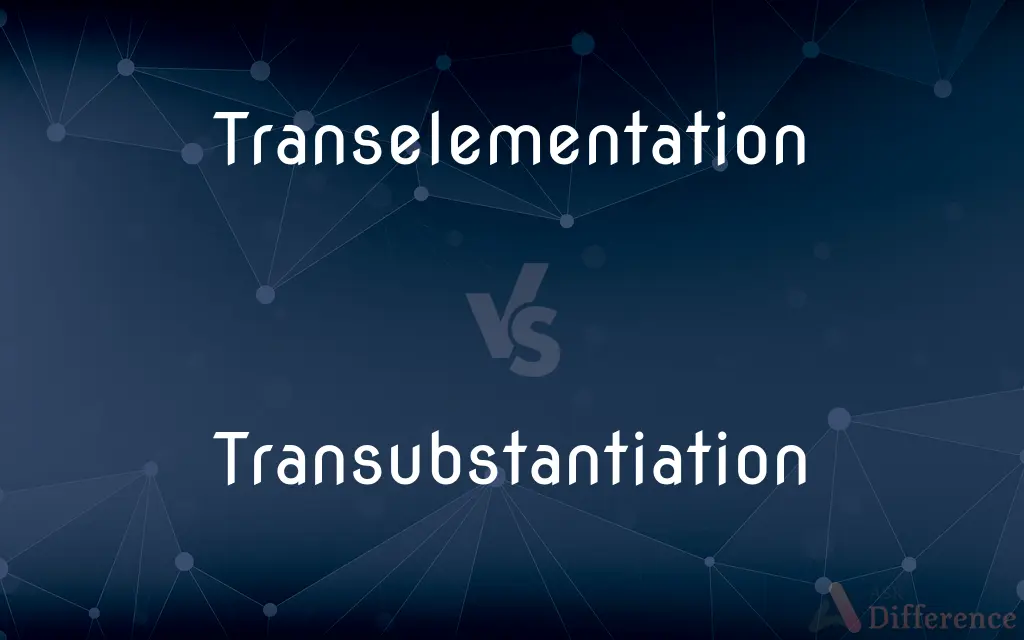Transelementation vs. Transubstantiation — What's the Difference?
By Urooj Arif & Maham Liaqat — Updated on May 3, 2024
Transelementation suggests a change in purpose or significance of elements during a religious ceremony, while Transubstantiation posits that bread and wine become actual body and blood of Christ, retaining only appearance of breed and wine.

Difference Between Transelementation and Transubstantiation
Table of Contents
ADVERTISEMENT
Key Differences
Transelementation is a concept in some Christian traditions indicating a symbolic or spiritual change in the elements of bread and wine during the Eucharist, whereas Transubstantiation, according to Roman Catholic belief, involves a literal transformation of these substances into Christ's body and blood.
In Transelementation, the bread and wine maintain their physical properties but are understood to take on new spiritual significance for the believers. On the other hand, in Transubstantiation, the physical properties appear unchanged, but the substances are believed to be entirely transformed.
The idea of Transelementation is accepted in certain Protestant denominations which view the Eucharist as a commemorative act rather than a literal change. Conversely, Transubstantiation is a central tenet in Catholicism, emphasizing the mystery of the Eucharist as a true and substantial change.
Transelementation aligns more with a metaphorical interpretation, supporting a figurative understanding of Christ’s presence. In contrast, Transubstantiation supports a physical presence, which is a more literal and integral aspect of Catholic worship.
The theological implications of Transelementation versus Transubstantiation also affect the ritualistic practice. In churches favoring Transelementation, the focus might be more on the communal and memorial aspects, whereas, in Catholicism, the focus is on the sacramental and transformative encounter with Christ.
ADVERTISEMENT
Comparison Chart
Definition
Change in meaning or purpose of elements.
Literal change in the substance of elements.
Belief System
Some Protestant denominations.
Roman Catholic Church.
Nature of Change
Symbolic or spiritual.
Physical and actual.
Theological Focus
Commemorative and metaphorical.
Sacramental and literal.
Perception of Presence
Spiritual or symbolic presence of Christ.
Physical and real presence of Christ.
Compare with Definitions
Transelementation
Common in non-Catholic Christian traditions.
Transelementation is observed in various Protestant services.
Transubstantiation
The doctrine that bread and wine become the actual body and blood of Christ.
Transubstantiation occurs during Catholic Mass.
Transelementation
Focuses on the remembrance of Christ’s teachings.
Transelementation emphasizes the memorial aspect of communion.
Transubstantiation
Affects the sanctity and reverence of the sacrament.
Transubstantiation elevates the communion to a divine act.
Transelementation
A change in the spiritual significance of Eucharistic elements.
In Transelementation, the bread symbolizes Christ’s body.
Transubstantiation
Involves a mystery of faith beyond physical evidence.
Despite appearances, Transubstantiation teaches a real change.
Transelementation
Reflects a metaphorical interpretation of the Eucharist.
Through Transelementation, the wine gains a new meaning.
Transubstantiation
Emphasizes the literal presence of Christ in the Eucharist.
Catholics believe in the physical presence of Christ post-Transubstantiation.
Transelementation
Supports a figurative presence of Christ.
The church teaches Transelementation to signify Christ's spiritual presence.
Transubstantiation
Central to Catholic Eucharistic theology.
Transubstantiation is taught in all Catholic catechisms.
Transelementation
(obsolete) transubstantiation
Transubstantiation
Transubstantiation (Latin: transubstantiatio; Greek: μετουσίωσις metousiosis) is, according to the teaching of the Catholic Church, "the change of the whole substance of bread into the substance of the Body of Christ and of the whole substance of wine into the substance of his Blood. This change is brought about in the eucharistic prayer through the efficacy of the word of Christ and by the action of the Holy Spirit.
Transelementation
Transubstantiation.
Transubstantiation
Conversion of one substance into another.
Transubstantiation
In many Christian churches, the doctrine holding that the bread and wine of the Eucharist are transformed into the body and blood of Jesus, although their appearances remain the same.
Transubstantiation
(Roman Catholic) The doctrine holding that the bread and wine of the Eucharist are essentially transformed into the body and blood of Jesus.
Transubstantiation
(by extension) Conversion of one substance into another.
Transubstantiation
A change into another substance.
Transubstantiation
The doctrine held by Roman Catholics, that the bread and wine in the Mass is converted into the body and blood of Christ; - distinguished from consubstantiation, and impanation.
Transubstantiation
The Roman Catholic doctrine that the whole substance of the bread and the wine changes into the substance of the body and blood of Christ when consecrated in the Eucharist
Transubstantiation
An act that changes the form or character or substance of something
Common Curiosities
Which denominations believe in Transelementation?
Various Protestant denominations adopt this belief, contrasting with Catholic doctrine.
How does Transelementation differ from Transubstantiation?
Transelementation suggests a symbolic change, while Transubstantiation posits a physical transformation.
Can Transelementation be considered a form of symbolic remembrance?
Yes, it primarily emphasizes the commemorative nature of the Eucharist.
What does Transubstantiation entail?
It involves the bread and wine of the Eucharist literally becoming the body and blood of Christ.
Does Transelementation have a biblical basis?
It is more loosely based on scriptural interpretations focusing on symbolic meanings.
What is Transelementation?
It is the belief that the elements of the Eucharist change in spiritual significance but not in substance.
Why is Transubstantiation significant in Catholic worship?
It underscores the literal presence of Christ, making the Eucharist a central sacramental act.
How do theologians justify Transubstantiation?
It is supported by Church tradition and theological interpretation of Scripture.
What are the implications of Transelementation for Christian practice?
It influences the understanding of the Eucharist as a spiritual and communal activity.
Is belief in Transubstantiation required for Catholics?
Yes, it is a fundamental aspect of Catholic faith and practice.
How do participants in a Eucharist perceive Transelementation?
They engage with the Eucharist as a memorial to Christ’s teachings and sacrifice.
How is Transubstantiation explained to children in the Catholic Church?
Through catechism and religious education that simplifies the concept while retaining its mystical elements.
What is the experience of Eucharist under Transubstantiation?
Participants believe they are receiving Christ himself, not just symbols.
How do churches teach Transelementation to their congregations?
Through educational programs that highlight the symbolic and spiritual significance of the Eucharist.
What scriptural bases support Transubstantiation?
Passages like Jesus’ words at the Last Supper, "This is my body... This is my blood," are cited.
Share Your Discovery

Previous Comparison
Naartjie vs. Orange
Next Comparison
Desire vs. AspireAuthor Spotlight
Written by
Urooj ArifUrooj is a skilled content writer at Ask Difference, known for her exceptional ability to simplify complex topics into engaging and informative content. With a passion for research and a flair for clear, concise writing, she consistently delivers articles that resonate with our diverse audience.
Co-written by
Maham Liaqat















































